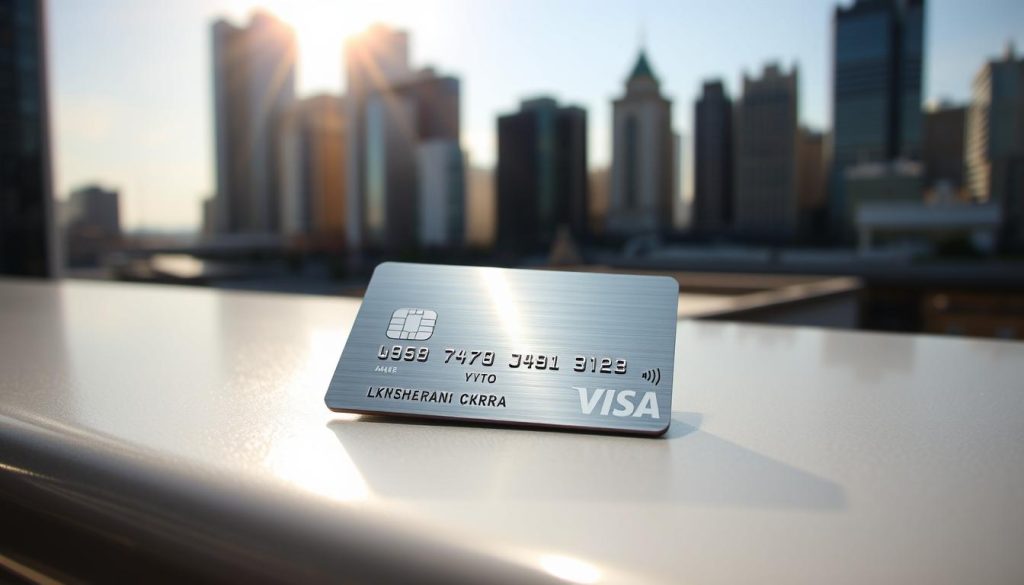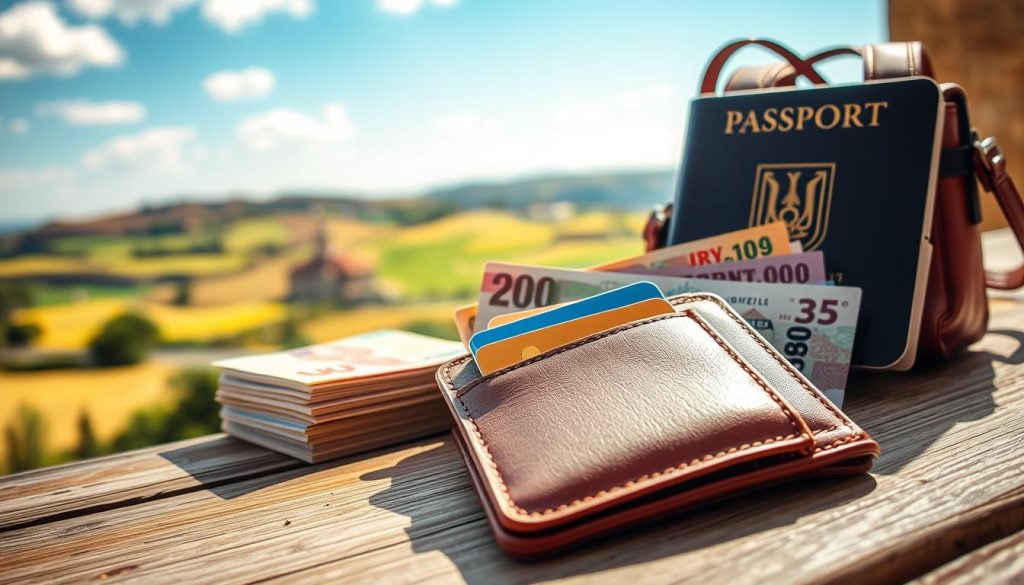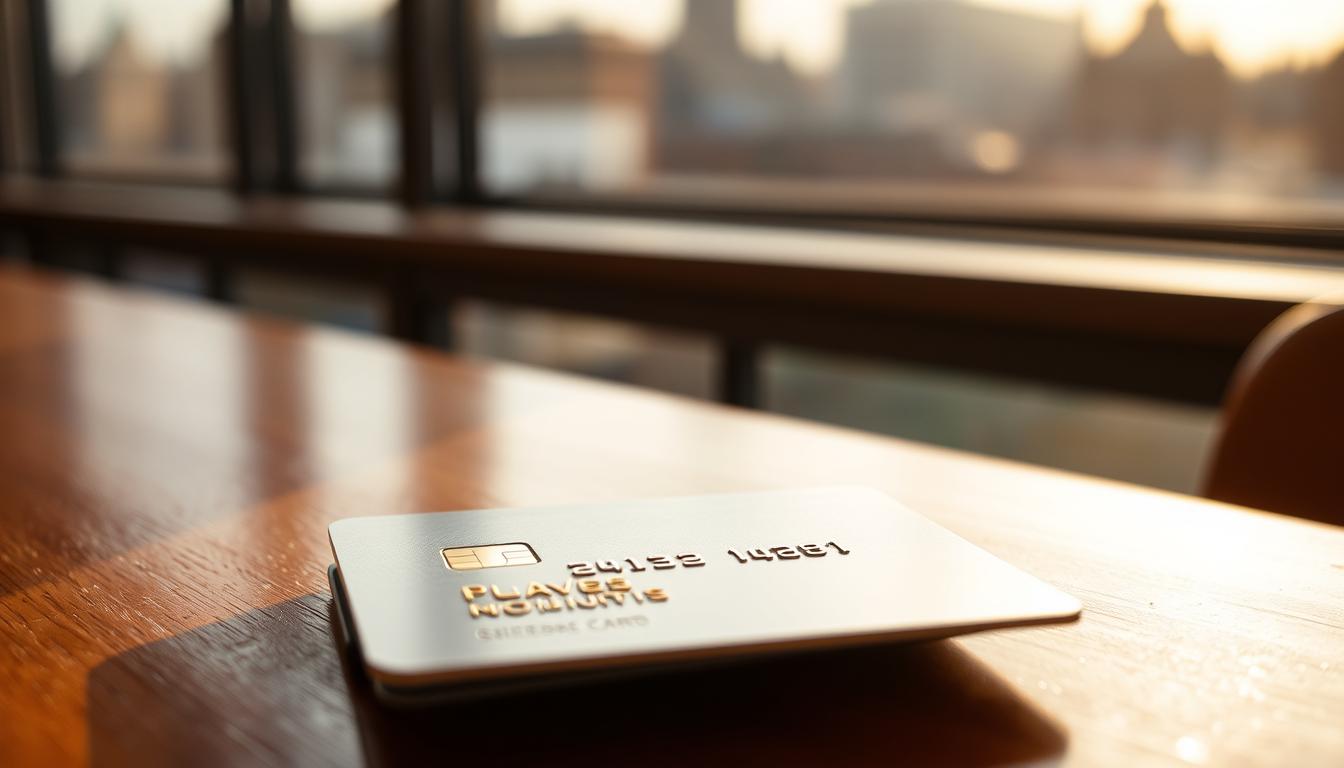✓ Accommodations✓ Flights✓ Rental Cars
Did you know that over 90% of payment terminals in many countries now support contactless transactions? This means your travel card or smartphone can make payments seamless and secure. Planning your finances for an international trip doesn’t have to be stressful—this guide is here to help.
Whether you’re exploring bustling cities or quaint towns, understanding your payment options is key. From cash to cards, we’ll walk you through the best ways to manage your money. You’ll also find reviews of popular travel money card providers like Wise and Netspend, so you can choose what works for you.
This guide is packed with practical tips and up-to-date information to make your trip smoother. Ready to dive in? Let’s get started!
Introduction to Ukraine’s Money and Payment Landscape
Navigating a new country’s financial system can feel overwhelming, but understanding the basics makes it easier. In Ukraine, the official currency is the hryvnia (₴), which has been in use since 1996. Knowing how to handle this money will help you make smarter decisions during your trip.
What to Expect When Planning Your Trip
Ukraine’s payment landscape is a mix of traditional and modern methods. Cash is still widely used, especially in smaller towns and rural areas. However, card payments are becoming increasingly popular in cities like Kyiv and Lviv.
“Carrying a mix of cash and cards ensures you’re prepared for any situation,”
says a frequent traveler.
Here’s a quick breakdown of common payment methods:
- Cash: Essential for small purchases, tips, and rural areas.
- Cards: Accepted in most urban establishments, including restaurants and shops.
- Contactless Payments: Growing in popularity, especially in larger cities.
Overview of Ukrainian Hryvnia and Local Payment Trends
The hryvnia comes in banknotes of 1, 2, 5, 10, 20, 50, 100, 200, 500, and 1000 ₴. Coins, known as kopiyky, are used for smaller amounts. Understanding this currency is key to setting your travel budget.
Modern payment trends are shaping travel in Ukraine. Many businesses now accept cards, and contactless payments are on the rise. However, it’s still wise to carry some cash for markets, public transport, and smaller vendors.
| Payment Method | Best For |
|---|---|
| Cash | Markets, tips, rural areas |
| Cards | Restaurants, shops, urban areas |
| Contactless | Convenient, fast transactions |
By understanding Ukraine’s money system, you can plan your finances effectively and enjoy a stress-free trip.
Understanding the Ukrainian Hryvnia and Current Exchange Rates
Exchange rates can make or break your travel budget, so understanding them is crucial. The Ukrainian hryvnia (UAH) is the official currency, and its value fluctuates daily. For example, as of July 2024, 1 USD equals approximately 41.1 UAH. These changes can directly impact how much you spend during your trip.

How Exchange Rates Affect Your Budget
Daily fluctuations in the exchange rate can significantly influence your spending power. If the rate drops, your money goes further. But if it rises, you might end up spending more than planned. For instance, a 5% increase in the rate could add up quickly over a week-long trip.
To stay ahead, monitor the mid-market rate. This is the real-time rate banks use, and it helps you avoid unnecessary fees. Setting alerts on apps like XE or Currency Converter can keep you informed about rate changes.
Using Online Currency Converters Effectively
Reputable online tools like Wise or OANDA can help you lock in better rates. These platforms provide real-time data and are user-friendly. For example, you can check the current exchange rate before making a large purchase or withdrawing cash.
Here are some tips for using these tools:
- Compare rates across multiple platforms to find the best deal.
- Set up rate alerts to track changes before and during your trip.
- Use mid-market rates to avoid hidden fees.
By staying informed and using these tools, you can maximize your budget and enjoy a stress-free trip.
Best Options for Travel Money Cards in Ukraine
Choosing the right travel money card can make your trip smoother and more cost-effective. Specialized cards often offer better exchange rates and lower fees compared to regular bank cards. This section reviews popular options like Wise and Netspend, helping you decide which money card suits your needs.
Review of Popular Providers
When it comes to travel money cards, provider like Wise stands out for its multi-currency features. The Wise Multi-Currency Card allows you to hold and spend in multiple currencies with low conversion fees. It also uses the mid-market exchange rate, saving you money on every transaction.
Netspend, another popular card provider, offers prepaid options that are easy to manage. While it doesn’t support multiple currencies, it’s a solid choice for those who prefer simplicity and straightforward fee structures.
Features to Look for in a Travel Money Card
Not all travel money cards are created equal. Here are some key features to consider:
- Low Conversion Fees: Cards like Wise offer competitive rates, ensuring you get more value for your money.
- App Management: Manage your card on the go with user-friendly apps.
- ATM Withdrawals: Check for free or low-cost withdrawal options to avoid extra fees.
- Security Measures: Look for cards with robust security features like fraud protection and instant card freezing.
By comparing these features, you can find a money card that aligns with your travel habits and budget.
| Feature | Wise | Netspend |
|---|---|---|
| Multi-Currency Support | Yes | No |
| Conversion Fees | Low | Moderate |
| App Management | Yes | Yes |
| ATM Withdrawal Fees | Free up to $350/month | Varies by location |
Whether you choose a provider like Wise or another card provider, understanding these features ensures you make the most of your travel budget. Take the time to compare options and select a card that meets your needs.
Debit Cards for Ukraine Travel: Benefits and Considerations
Using a debit card while traveling can simplify your financial transactions and keep your spending on track. It’s a convenient way to access cash and make purchases without carrying large amounts of money. However, there are important factors to consider, such as fees and accessibility.

Comparing International Debit Card Options
Not all debit cards are created equal when it comes to international travel. Some cards, like Wise and Monzo, offer low foreign transaction fees and competitive exchange rates. For example, Wise uses the mid-market rate, which can save you money on every purchase.
Other cards, like Chime, have no foreign transaction fees but may have daily withdrawal limits. It’s essential to compare features like ATM access, conversion fees, and app management to find the best fit for your trip.
Typical Costs and Benefits
Using a debit card overseas often comes with lower fees compared to credit cards. However, some banks charge for international ATM withdrawals or currency conversions. For instance, Netspend cards may have fees around 4% for foreign transactions.
On the flip side, the convenience of card payments in major tourist areas can’t be overstated. Many establishments accept contactless payments, making transactions quick and secure.
Preparing Your Debit Card for Travel
Before you leave, notify your bank about your travel plans to avoid any issues with ATM withdrawals. Some banks may block transactions if they suspect fraudulent activity. Additionally, check your card’s daily and monthly withdrawal limits to ensure they meet your needs.
“Notifying your bank in advance is a simple step that can prevent unnecessary headaches,”
says a frequent traveler.
Optimizing ATM Access and Security
When using your debit card abroad, look for ATMs affiliated with major banks to minimize fees. For example, Privatbank and Oschadbank in Ukraine offer reliable options. Always prioritize security by covering the keypad when entering your PIN and avoiding standalone ATMs in secluded areas.
By choosing the right card and taking these precautions, you can enjoy a seamless and secure travel experience.
Prepaid Cards vs. Credit Cards: Which Serves You Best?
When planning your trip, deciding between prepaid and credit cards can significantly impact your travel experience. Both options have their advantages, but understanding their differences helps you make the right choice. Let’s break down the pros and cons of each to guide your decision.
Pros and Cons of Prepaid Travel Cards
Prepaid cards are a popular choice for travelers who want to stick to a budget. These cards allow you to load a specific amount of money, ensuring you don’t overspend. They also minimize financial risk if lost or stolen, as they’re not linked to your bank account.
However, prepaid cards can come with extra fees, such as reloading or inactivity charges. Some cards may also have limited acceptance in certain regions. Despite these drawbacks, they’re a great option for those who prefer upfront budgeting and controlled spending.
When a Credit Card May Be More Suitable
Credit cards offer flexibility and rewards that can enhance your travel experience. Many cards provide perks like airline miles, hotel points, or cashback on purchases. For frequent travelers, these benefits can add up quickly.
However, credit cards often come with foreign transaction fees, which can range from 1% to 3% of each purchase. Additionally, interest charges can increase costs if you don’t pay off your balance in full. If you’re comfortable managing your spending, a credit card can be a valuable tool.
“Choosing the right card depends on your travel habits and financial goals,”
says a seasoned traveler.
Here’s a quick comparison to help you decide:
- Prepaid Cards: Ideal for budgeting, limited fees, and security.
- Credit Cards: Best for rewards, flexibility, and spreading costs.
Before making a decision, carefully review the terms of each card. Look for hidden monthly fees, foreign transaction charges, and other potential costs. By understanding these details, you can choose the option that best suits your needs and ensures a smooth travel experience.
Ukraine: Ultimate Travelers Guide to Currencies & Payments
Managing your finances while traveling doesn’t have to be complicated—this guide simplifies it for you. Whether you’re exploring bustling cities or quaint towns, understanding your payment options is key to a smooth trip. Let’s recap the best ways to handle your money and ensure you stay within your budget.

- Cash: Essential for small purchases, tips, and rural areas.
- Cards: Widely accepted in urban areas, with contactless payments gaining popularity.
- Contactless Payments: Fast and secure, especially in larger cities.
Each method has its costs. For example, cash exchanges may come with fees, while cards might charge foreign transaction fees. Understanding these expenses helps you plan better and avoid surprises.
“Choosing the right payment option based on your spending habits ensures a stress-free experience,”
says a frequent traveler. Whether you prefer the flexibility of cards or the simplicity of cash, selecting the right option is crucial. Thorough planning and understanding the associated costs will make your trip more enjoyable and financially manageable.
Planning Your Travel Budget: Cash Versus Card Spending
Balancing cash and card use is essential for a stress-free travel experience. Knowing when to rely on each method can save you money and ensure you’re prepared for any situation. Here’s how to allocate your funds wisely and make the most of your spending.
Strategies for Budgeting and Managing Funds
Start by dividing your budget between cash and card payments. Cash is ideal for small purchases, tips, and rural areas where card acceptance may be limited. On average, daily spending on meals and transport can range from $2 to $14, depending on your travel style.
For larger expenses like accommodation or dining, cards are more convenient. Many establishments in urban areas accept contactless payment, making transactions quick and secure. Budget travelers can expect to spend around $6 per night on lodging, while mid-range options cost about $15.
- Allocate 30% of your budget to cash: Use it for markets, public transport, and emergencies.
- Use cards for 70% of expenses: Ideal for hotels, restaurants, and shopping.
- Track daily spending: Keep a record to avoid overspending.
Booking in advance can also save you money. For example, securing accommodation early often results in lower rates. Public transport is another cost-effective option, with an average fare of $0.92 per ride.
“Having a mix of cash and cards ensures you’re ready for any situation,”
says a seasoned traveler. By planning ahead and diversifying your payment methods, you can enjoy a smooth and budget-friendly trip.
Tips for Minimizing Foreign Transaction and Service Fees
Traveling abroad can be exciting, but hidden fees can quickly add up and strain your budget. By understanding how to avoid unnecessary costs, you can save both time and money. Here are some practical tips to help you minimize foreign transaction fees and service charges.
First, choose a provider that offers low or no fees for overseas transactions. Many banks and financial institutions charge extra for international use, but some, like Charles Schwab, reimburse ATM fees. Credit cards like Chase Sapphire Preferred and Capital One also eliminate foreign transaction fees, making them a smart choice for travelers.

Another way to save is by timing your transactions strategically. Exchange rates fluctuate throughout the day, so monitor them using apps like XE or Wise. Making purchases or withdrawals during favorable rate periods can significantly reduce costs.
Here are some additional tips to keep in mind:
- Use local currency: When prompted, always choose to pay in the local currency rather than your home currency. This avoids Dynamic Currency Conversion (DCC) fees, which often come with unfavorable rates.
- Research fee structures: Before activating or using any travel card, thoroughly review its fee structure. Look for hidden charges like reloading fees or inactivity penalties.
- Manage your accounts: Notify your bank of your travel plans to avoid card blocking issues. Also, set up alerts to track spending and avoid exceeding limits.
By following these strategies, you can minimize unnecessary fees and make the most of your travel budget. A little preparation goes a long way in ensuring a smooth and cost-effective trip.
Practical Advice on ATM Withdrawals and Safe Cash Practices
Accessing cash while traveling abroad can be straightforward if you know the right steps. Whether you’re using a debit card or a travel money card, understanding how to make atm withdrawals safely and efficiently is essential. Here’s a guide to help you navigate the process and keep your money secure.
How to Make ATM Withdrawals Abroad
When using an atm overseas, start by locating a machine affiliated with a major bank. These typically have lower fees and are more secure. Insert your card and follow the on-screen instructions. Most foreign ATMs require a 4-digit PIN, so ensure your card is set up accordingly before your trip.
Check your bank’s daily and weekly withdrawal limits to avoid declined transactions. For example, PrivatBank allows up to UAH 20,000 per transaction, while Oschadbank permits UAH 100,000 daily. Smaller, frequent withdrawals are safer than carrying large sums of cash.
Here’s a quick checklist for smooth transactions:
- Use ATMs in well-lit, secure locations.
- Cover the keypad when entering your PIN.
- Always choose to pay in the local currency to avoid extra fees.
Maintaining Security When Carrying Cash
Carrying cash abroad requires extra caution. Divide your money and store it in multiple places, such as a wallet, hidden pouch, or even your shoes. This reduces the risk of losing everything if theft occurs. A decoy wallet with a small amount of cash and fake cards can also deter thieves.
Notify your bank of your travel plans to prevent your card from being blocked. Additionally, monitor your accounts regularly to spot any unauthorized transactions. If an atm malfunctions or charges unexpected fees, contact your bank immediately for assistance.
“Staying vigilant and prepared can make all the difference in keeping your money safe,”
says a frequent traveler.
| Bank | Daily Withdrawal Limit |
|---|---|
| PrivatBank | UAH 20,000 |
| Oschadbank | UAH 100,000 |
| Ukreximbank | UAH 25,000 |
By following these tips, you can make atm withdrawals confidently and handle cash securely during your travels. Preparation and awareness are your best tools for a hassle-free experience.
Security Measures: Keeping Your Money Safe Abroad
Keeping your money safe while traveling is a top priority for any trip. With the right precautions, you can protect your funds and personal data from potential risks. Here are some essential tips to ensure your financial security abroad.
Start by setting up security features on your travel money card and bank account. Many card provider like Wise and Netspend offer features like two-factor authentication and quick card freezing. These tools add an extra layer of protection against unauthorized access.
Monitoring your transaction activity is another crucial step. Regularly check your account for any suspicious charges. If you notice anything unusual, contact your card provider immediately to address the issue.
Always use secure networks when accessing your account online. Avoid public Wi-Fi for financial transactions, as it can be vulnerable to hackers. Instead, use a VPN or a trusted mobile data connection.
Take measures in advance to safeguard your funds. Keep a backup card separate from your primary one. This ensures you have access to money if your main card is lost or stolen. Additionally, notify your bank of your travel plans to avoid unexpected card blocks.
“Being proactive about security can save you from potential headaches and financial losses,”
says a frequent traveler.
Here’s a quick checklist for staying secure:
- Enable two-factor authentication on all financial apps.
- Use ATMs in well-lit, secure locations and cover the keypad when entering your PIN.
- Carry only the cash you need for the day and store the rest in a safe place.
By following these tips, you can travel with confidence, knowing your money is well-protected. A little preparation goes a long way in ensuring a smooth and secure trip.
Managing Currency Exchange on Arrival and During Your Trip
Managing currency exchange during your trip can save you a lot of time and money. Knowing where and how to exchange your funds ensures you get the best rates and avoid unnecessary fees. Here’s a guide to help you navigate currency exchange smoothly.
Best Places to Exchange Money
When you arrive, look for reputable exchange bureaus or banks. These are often the safest and most reliable options. Avoid unofficial services, as they may offer unfavorable rates or even scams. Major airports and city centers usually have trustworthy exchange points.
Comparing Rates and Avoiding Scams
Always compare rates at different bureaus before making a transaction. Look for the mid-market rate, which is the fairest benchmark. Be cautious of hidden fees or commissions that can reduce the amount you receive. A good rule of thumb is to avoid exchanging money at hotels or tourist-heavy areas, as they often charge higher rates.
“Taking a few minutes to compare rates can save you a significant amount of money,”
says a seasoned traveler.
Using Travel Money Cards for Exchanges
Travel money cards are a convenient option for in-country exchanges. They allow you to lock in rates before your trip and avoid carrying large amounts of cash. Many cards also offer low conversion fees, making them a cost-effective choice. Check if your card supports the local currency to minimize additional charges.
Understanding Different Exchange Offers
Exchange bureaus often advertise different types of offers, such as “no commission” or “best rates.” Read the fine print to understand what these offers actually mean. Some may have hidden conditions that reduce the overall value. Always ask for a receipt and double-check the amount you receive.
Here’s a quick comparison of exchange options:
| Option | Pros | Cons |
|---|---|---|
| Banks | Secure, reliable rates | May have limited hours |
| Exchange Bureaus | Convenient, competitive rates | Risk of hidden fees |
| Travel Money Cards | Locked rates, low fees | May not be accepted everywhere |
By following these tips, you can manage your currency exchange effectively and enjoy a hassle-free trip. Preparation and awareness are key to getting the best value for your money.
Traveler Reviews and Card Provider Comparisons
Traveler reviews and card provider comparisons can offer valuable insights for your next trip. Hearing from real users helps you understand what works best for different travel styles. Whether you’re a frequent flyer or planning a one-time adventure, these insights can guide your decision.
Insights from Real User Experiences
Many travelers praise Wise for its low fees and multi-currency support. One user shared, “The app is easy to use, and I saved a lot on exchange rates during my trip.” Another highlighted the excellent customer service, saying, “They resolved my issue within hours.”
On the other hand, Chase users appreciate its rewards program. A frequent traveler noted, “The points I earned covered my flight costs, making it a great choice for long trips.” However, some mentioned higher fees for international transactions.
Provider Comparisons for Different Traveler Needs
Choosing the right card depends on your travel habits. Here’s a quick comparison of popular providers:
- Wise: Best for low fees and multi-currency support. Ideal for frequent travelers who need flexibility.
- Chase: Great for rewards and perks. Suitable for those who travel often and want to maximize benefits.
- Travelex: Offers prepaid options with no foreign transaction fees. Perfect for budget-conscious travelers.
User experiences also highlight the importance of fee transparency. Many travelers recommend checking for hidden charges before choosing a card. For example, one user mentioned, “I didn’t realize there was an inactivity fee until it was too late.”
“Reading reviews and comparing providers saved me a lot of hassle during my trip,”
says a satisfied traveler. By considering these insights, you can find a card that matches your needs and ensures a smooth travel experience.
Conclusion
Planning your finances for an international trip can feel daunting, but with the right tools, it becomes manageable. This guide has covered essential tips for managing currencies, selecting the best travel cards, and budgeting effectively. Whether you prefer debit, prepaid, or credit cards, understanding their differences ensures you make the right choice for your needs.
Secure payment methods are crucial for a stress-free experience. Always stay informed about exchange rates and use trusted platforms for conversions. For tourists, carrying a mix of cash and cards is a smart strategy, especially in areas where card acceptance may vary.
Review this guide periodically as you plan your trip to stay updated with any new developments. By following these recommendations, you can maximize savings and ensure your financial security while traveling. Happy journeys!
The above is subject to change.
Check back often to TRAVEL.COM for the latest travel tips and deals.





